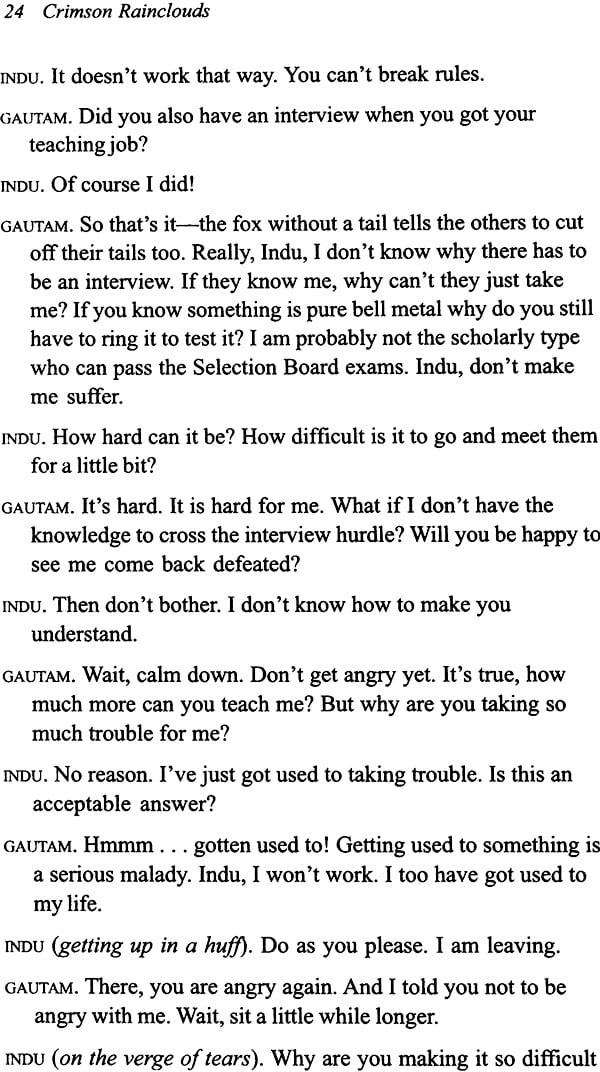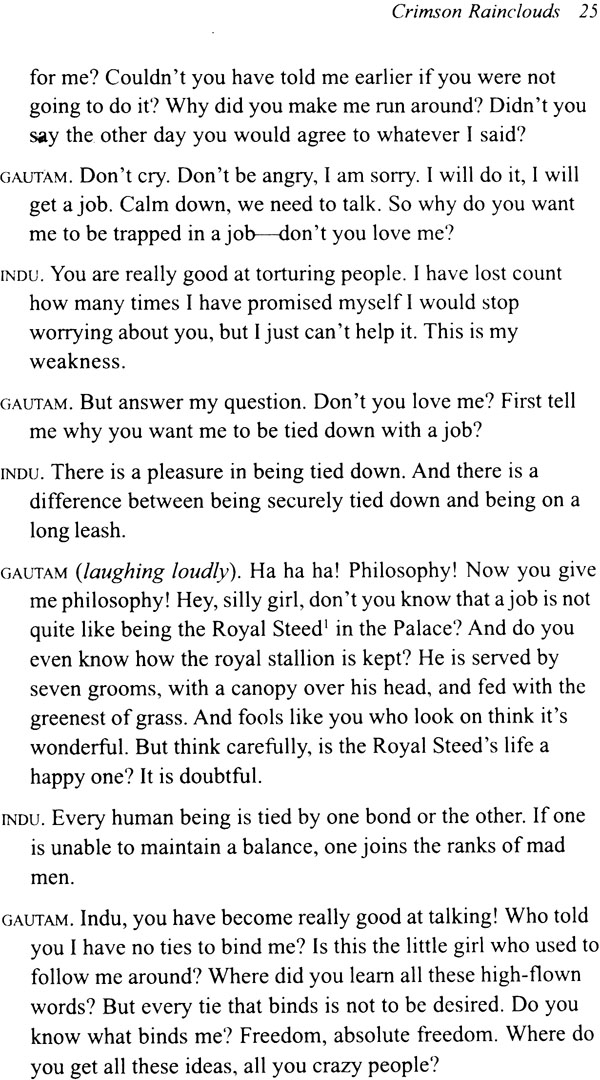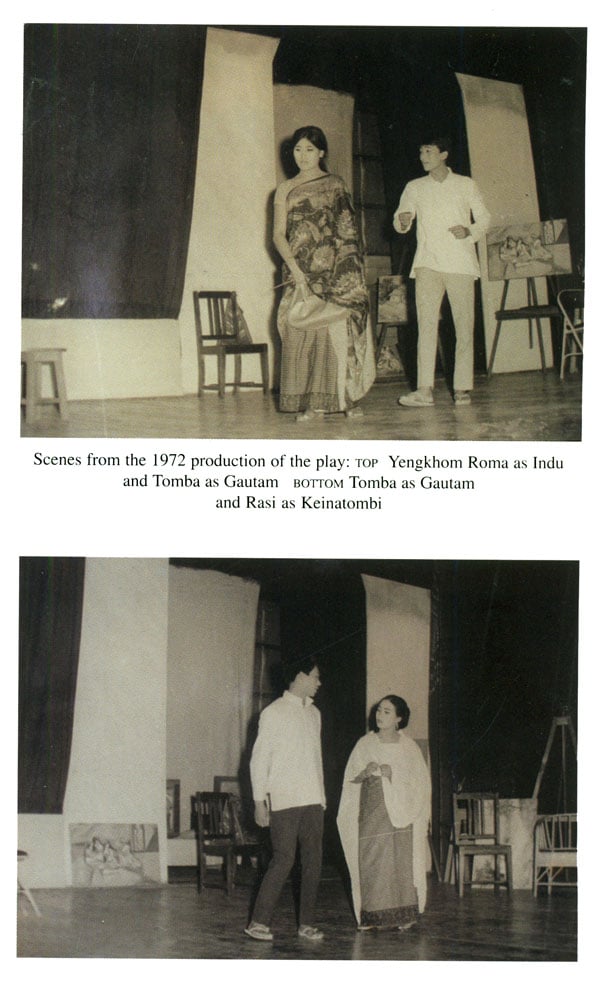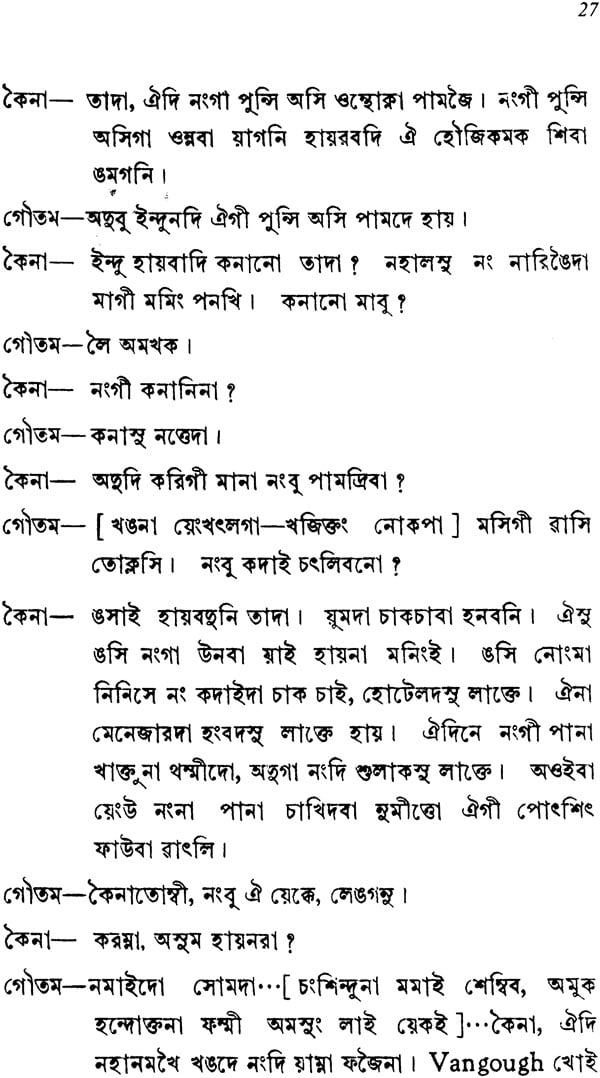
Crimson Rainclouds
Book Specification
| Item Code: | NAN617 |
| Author: | Binodini and L Somi Roy |
| Publisher: | Thema Books, Kolkata |
| Language: | Manipuri Text With English Translation |
| Edition: | 2012 |
| ISBN: | 9789381703151 |
| Pages: | 172 (8 Color Illustration) |
| Cover: | Hardcover |
| Other Details | 8.5 inch X 5.5 inch |
| Weight | 380 gm |
Book Description
In Crimson Rainclouds, a Manipuri play from the 1960s, an artist determined to uphold his freedom, is tom between his two loves, both only too gentle in their demands, and yet deeply caring. A sensitive man, he chooses art, knowing full well that he lets them down. While Indu would like him to change his lifestyle just a little bit, for recognition and comfort, Keinatombi would be happy to give him the little care and comfort that she thinks he needs for his art. For the time being at least, Gautam would go with her.
The play draws on the playwright's interactions with Ramkinkar Baij (1906-80), the eminent sculptor, with whom she studied in Santiniketan, and who has left behind a whole suite of sculptures and paintings of Binodini.
The English translation of the play appears for the first time, followed by the original, now out of print, in both the Bangla and Meitei Mayek scripts; along with stills from two productions of the play and a couple of paintings of Binodini by Ramkinkar Baij, and a self-portrait by Binodini.
Born a princess, MAHARAJKUMARI BINODlNI DEVl (7 February 1922-17 January 2011), broke free from the constraints of royalty to live to the full the life of an enlightened commoner, and emerge as an iconic pioneer in the evolution of Manipuri modernism, through her outstanding contributions to fiction, theatre, cinema, poetry, visual arts and dance. Collaborating with filmmaker Aribam Syam Sharma, she wrote the original scripts for his award winning films, Imagi Ningthem (My Son, My Precious, 1982) and Ishanou (The Chosen One, 1992), and the ballet film Sangai that won the British Film Institute's Outstanding Film of the Year Award in 1984.
Binodini Devi, who wrote under the name of Binodini, was awarded the Sahitya Akademi Award given by India's national academy of letters in 1979 for her novel The Princess and the Political Agent. She completed her memoirs, Maharaj Churachandgi Imung (The Maharaja s Household) in 2009.
L SOMI Roy is a US-based film curator and arts producer who has organized film exhibitions for major American museums. His writings on film and culture have appeared in Artforum, Asian Culture, Wide Angle, Black Film Bulletin, International Documentary, and The Drama Review and Persimmon. The son of M K Binodini Devi, his translations of her works from Manipuri to English include her short stories, the screenplay My Son, My Precious, and the forthcoming The Maharaja s Household. He lives in New York City.
At the retrospective exhibition of the paintings and sculptures of Ramkinkar Baij (1906-80), held recently at the National Gallery of Modern Art, New Delhi, an entire room was dedicated to Binodini and her peers as they appeared in the Master's works. In an interview, ate in life, Ramkinkar spoke of these young women he had known in Santiniketan in the 1940s. About Binodini, he said: 'There was Binodini-my student-from Manipur. I drew inspiration from her, though I never had a physical relationship with her. Mentally I was drawn towards her. When she was leaving, she wanted to give me her camera as a gift. I didn't take it. What would I do with it? It could just get lost, or stolen. Why bother!'
Crimson Rainclouds, a play written by M K Binodini Devi (7 February 1922-17 January 2011), sculptress, painter, filmscriptwriter, civil and gender rights activist, scholar and writer, is not about Ramkinkar and Binodini, but the Santiniketan memories colour the writing, not only with the Tagore songs (she was no mean singer herself), but also in the image of the quintessential artist that she conjures up. The deepseated commitment to personal freedom that characterizes Gautam the protagonist lies at the core of Ramkinkar's testament:
I am a traveller seeking emancipation along an extremely narrow and yet far-reaching path. There is no way one can follow this path without total dedication. All such journeys draw one into battles against antagonistic forces, with a delusory mist trying ceaselessly to confuse and mislead the free mind, calling for eternal anxiety and vigilance. I can see I am not alone. You are all with me. The vigil continues through the ages.
The young child of a poor family has held on to a vision- the one path open to him, to abhor domesticity, to abandon marriage and the rest. But I was never ungrateful to my parents.
The wonderful rhythmic interplay of life and death beside the infinitely flowing sources of life-let me watch.
Artists are naturally poor, for the irrational urge to work leaves them poor. Hence they have to depend on the kindness of the learned and the rasikas, with whom they somehow come to terms, and that's how it has always been.
Caught in a whirlwind of activities in the 1960s, did Binodini-di herself feel that she could not spare enough time for her art that she had trained in, with her Master in Santiniketan? And did the play grow out of that frustration? One wonders. The last few times I met her in Imphal, I found her drained-and exhausted.
Somi has touchingly recorded how the present book came into being. It was K S Radhakrishnan, the brilliant young sculptor who curated the Ramkinkar retrospective, a curatorial feat, who was generous enough to provide us with 'reproductions' of Rarnkinkar's Binodini portraits and help us re-create Binodini's Santiniketan memories. And Aribam Syam Sharma, an old friend, was of course there, to share with us his memories and associations of Binodini- di, and stills from the stage productions of the play. We are deeply grateful to both of them-and to Leikol, who are collaborating with us and hosting the release of the book at Imphal.











